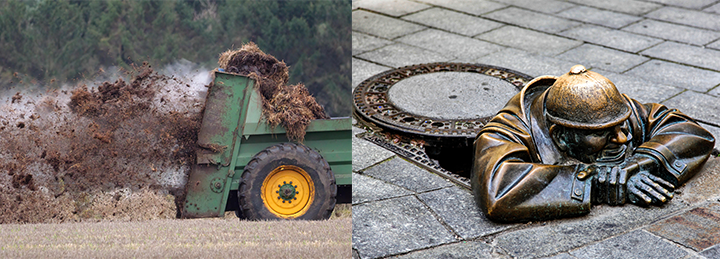3.1 Assessment of human exposure to antimicrobial resistance in the environment
In Section 2 you learned about some transmission routes from the environment to humans, among them the intake of contaminated drinking water and washing/recreation in surface water.
How important are these routes of exposure in practice? In this section you will be introduced to the concept of exposure assessment. The extent of exposure through different transmission routes depends on two factors:
- the concentration of resistant bacteria or ARGs in that compartment (the specific part of the environment where AMR can exist and be transmitted)
- the amount of that compartment that is taken up into the human body.
Together, these factors define the dose that is ingested (taken up through the mouth) or inhaled (taken up through air), according to the equation:
D = c × V
where D = dose, c = concentration of resistant bacterium/ARG in the compartment and V = volume ingested or inhaled per time unit through contact with that compartment.
You can see an example of the calculation of the dose of Extended Spectrum Beta Lactamase (ESBL) producing E. coli bacteria ingested during bathing in the extended learning section of the course.
There are some people whose occupations mean that they are particularly exposed to resistant bacteria through contact with the environment. These include, workers involved in sludge treatment or farmers/agricultural workers in contact with animal manure (Figure 5). For example, farmers who have direct contact with farmed animals can have a higher than usual prevalence of resistant bacteria because they are in regular and intensive contact with the animals that carry these bacteria (Van Cleef et al. 2015). Likewise, people who work in close contact with human wastewater or human sewage sludge are likely to have a high exposure to AMR bacteria present in faeces. Research studies of such occupationally exposed populations can demonstrate the existence of a particular transmission route.

In the environmental sector there are very few systematic studies of transmission through specific routes. In the next activity you will look at one particular study.
Activity 4: A study of human exposure to environmental AMR
Read the article ‘Scientists and surfers team up to assess antibiotic resistance’ (ECEHH, 2015) and answer the following questions in the space below:
- According to the article, which AMR indicator is being studied?
- Which transmission route and population are being investigated?
- What is the approach used to investigate whether this transmission route leads to human exposure?
- Do you think this study would be representative of the likelihood of (recreational) water users being colonised with this bacterium in your region as well? Why?
Discussion
- This study investigates a particular resistant bacterium: namely, E. coli bacteria resistant to third- and fourth-generation cephalosporins.
- The study investigates recreation (surfing) in bathing waters in England and Wales as a transmission route for these resistant strains of E. coli.
- The evidence consists of a comparison of the frequency that this bacterium is found in the guts of surfers and people who do not surf (the control group). Surfers are significantly more likely to carry third- and fourth-generation cephalosporin-resistant E. coli in their guts: about three times as frequently as in the control non-surfers.
- Whether this study would be representative of your region mainly depends on the concentrations of resistant E. coli that surfers would encounter, and also the overall prevalence of resistant E. coli in the general population.
You may want to read the full scientific study that this article was based on: ‘Exposure to and colonisation by antibiotic-resistant E. coli in UK coastal water users: environmental surveillance, exposure assessment, and epidemiological study (Beach Bum Survey)’ (Leonard et al., 2018).
3 Humans and the environment: exposure and exacerbation




